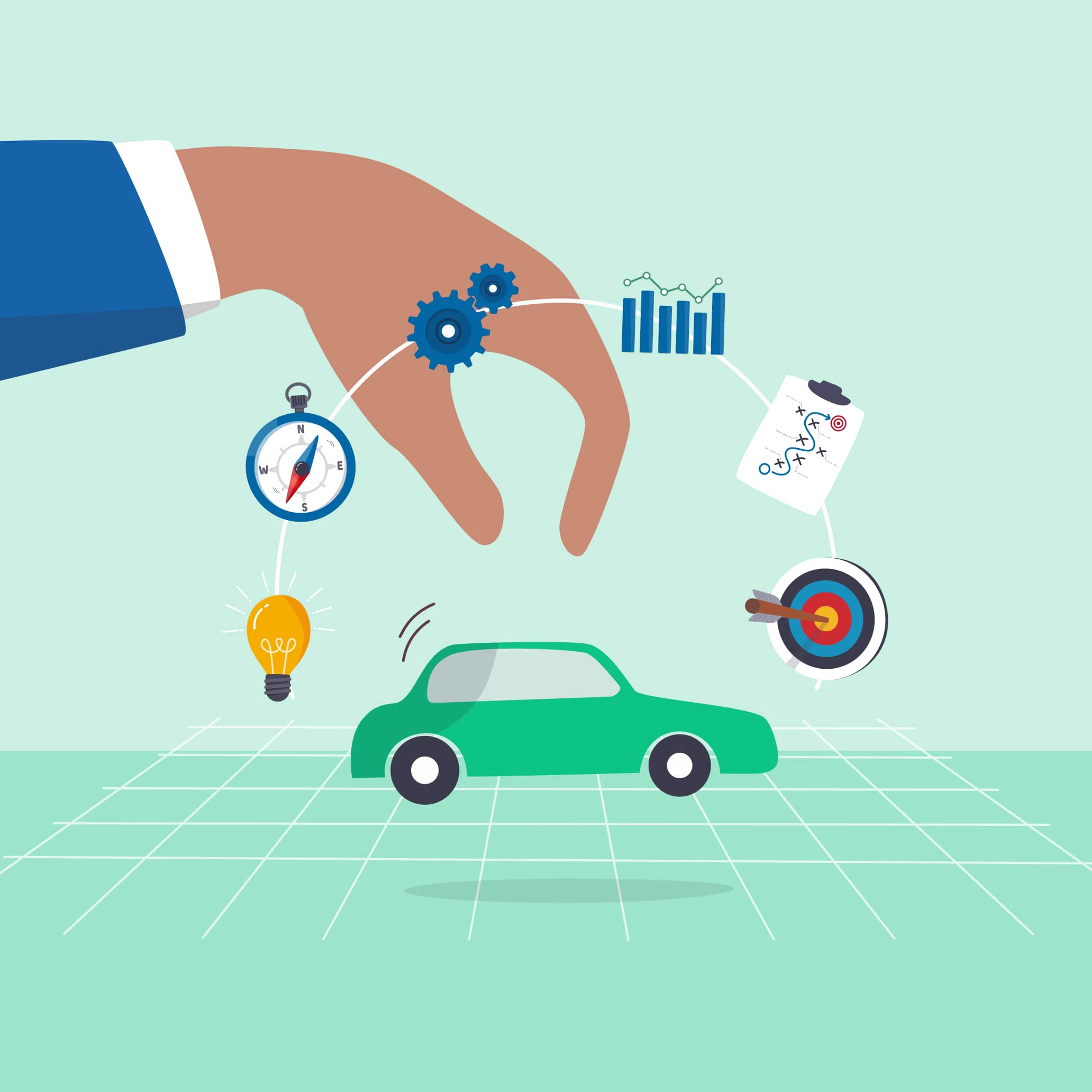

TABLE OF CONTENTS
Parking is an increasingly massive headache for multifamily management teams. Given the simultaneous shrinking of the average lot size and increase in households with 3+ cars, properties are struggling to keep up with parking demand.
That’s why, on the surface, car stackers seem like the perfect solution. This space-saving parking solution, also called vehicle stackers or car lifts, was a popular solution for a while. But property managers are quickly realizing that it’s not the quick-fix solution they were hoping for.
For many of the property managers that we’ve talked to, car stackers are starting to top their list of headaches when it comes to keeping their property running smoothly.
Before we get into why this solution doesn’t hold up – and most importantly what the better alternative is – let’s first talk about how exactly these systems work.
Car stackers, in the simplest terms, use a mechanical system to stack cars vertically, maximizing space.
The first car drives onto the platform at the base of the stacker and exits their vehicle. Once the driver is out, the stacker activates, holding the car steady and lifting the platform vertically, making room beneath for another car. While many stackers are two levels, some can be 3 or more, depending on the vertical space available.
To retrieve a car, the process reverses. The stacker lowers the car back to ground level, letting the driver get in their car and drive away.
The value of this can be obvious, especially when you need more space in your garage for additional cars, whether as a result of city ordinances or resident needs. This allows you to take advantage of the vertical space you already have without needing to expand the current footprint of your parking garage.
However, they usually come with more hassle than they’re worth.
Property managers or developers install their shiny new car stackers and sit back to revel in the space efficiency they now have. However, they’re often quickly smacked with the harsh reality that car stackers create more problems than they actually solve.
Property managers are typically quickly swarmed with complaints from residents once they install car stackers.
Many of these complaints center around how difficult to use they are. Jamie D’Allessandro, Principal at Windy Hill Development mentioned the one-hour training that residents have to go through just to use the stackers. This places a burden on both residents and staff.
A reddit user mentioned their annoyances with using the stacker system:
“The gripe I had with it was just the added time needed to do things…the most annoying thing was that you had to be the one to manually go to the console and start the process, and then be the one to open the door, drive your car in, get out, and then also be the one to close the door, too.”
This complicated process also leads to damage to cars. Not situating your car the perfect way on the platforms can lead to scratches on your car, or even knocked off side mirrors. And this is not even to mention the damage that can happen when the machines malfunction…which we’ll touch on in the next section.
Because of all of the hassle associated with these spots, residents don’t want to park in them. Windy Hill Development’s D’Alessandro told us:
“We’ve been open 2 years now, and only half of the [stacker] parking spots are even rented.”
He continues, “No one wants to use the stackers. Many of the residents prefer to just park on the street or pay for regular, non-stacker spots in other garages nearby.”
One of our other customers, Vespaio, has experienced a similar situation. While occupancy for their non-stacker spots is consistently over 90%, the occupancy for the car stacker spots is only at 17%, despite both types of spots being the same price. It’s extremely clear that even when priced the same — and even though stacker spots fit two cars instead of one — residents strongly prefer avoiding the stacker spots.
Like we mentioned, car stackers can be prone to malfunctioning. And since they’re big, heavy pieces of machinery, malfunctions can cause some serious harm.
All it takes is a quick online search to discover some horror stories. One resident’s car door got crushed between platforms, and another car was stuck in a stacker for 9 months, with no solution in sight.
Laila Zamarano, a Regional Manager in Oakland, Calif., explained the complications these malfunctions can cause. “As recently as last week, an irate resident flagged me down because she couldn’t get her car out of the stacker. I had no idea what else to do, so I just had to pay for her Lyfts to/from work.”
When these problems do occur, finding a way to fix the machines can also be a whole new problem in itself. One reddit user mentioned that they were waiting 2 weeks for a repair to their stackers. Laila’s property has an even longer wait time; since the company that made their stackers went out of business, her team has struggled for months to find someone to maintain these no-longer-supported stackers.
Other incidents out of your control like internet outages can lead to problems, since internet is often needed to operate the car stackers. So your residents or staff may sometimes find themselves with no way to retrieve their cars.
The cost of car stackers is often a major drawback as well. Although the cost of installing the stackers themselves is extremely high, ranging anywhere from $4,000 to $70,000 on average, depending on the number of units and the models, this doesn’t take into account the additional height needed and time it takes to prep a site.
For example, one of our customers, The Palomino, was required by their city’s planning department to provide more parking spots. Instead of adding another level to the garage, they figured car stackers were the best option to make the most of their existing space. However, that involved digging a “pit” below the first floor of the garage, adding extra height to the first floor and added a month of construction time. The construction and hardware costs added $2 million in direct costs, for only an extra 25 parking spots, or $80,000 per spot.
The size of vehicles is also a major limitation when it comes to car stackers. Many of the options on the market only allow for sedans to park on the stackers, which disqualifies many residents’ vehicles.
One developer we talked to explained their time-consuming vetting process where, “we need to look up the make/model/year of any vehicle that wants to park on the stackers and confirm it will fit.”
This size problem will only continue to grow as the trend in the United States towards bigger cars rises. Crossovers and SUVs are now at 50% market share, and many carmakers are even considering (or already have) scrapped sedans from their new car lineup.
This means that, increasingly, fewer cars are going to be able to fit on these stackers. Laila Zamarano said that many of the properties she oversees are already experiencing this rise in the percentage of residents with larger vehicles.
A common phrase when we talk to property managers or developers about car stackers is “they’re a necessary evil to create more parking.”
But often, that’s not the case. Usually, properties realize that it’s not that they have too little parking, they’re just not managing it correctly. Before a property digs deep into their pockets to invest in hardware, they should try better parking software first.
Using a digital parking management can help you to make the most of all of the spots you already have.
If you feel like you’re short on spots, better software can’t double your parking utilization — but 20-30% increases are common, like the 27% increase we garnered at Greystar’s first partner property with Parkade, just through better records and self-serve technology.
Software like Parkade digitizes your parking lot or garage, prices it correctly, and keeps your records 100% up-to-date. As a result, your parking utilization is maximized, eliminating the need for stackers in the first place, even in lots or garages where space is tight.
For long-term parking, Parkade makes it possible for residents to reserve the parking they need. They’re also able to capitalize on periods when they don’t need their spot, like when they’re out of town, for example, by making them available for short-term use which guests can take advantage of.
Building managers can also make the most of idle spots between leases by offering them up for short-term use.
Our easy digital enforcement tools also boost capacity by ensuring only those who have an active reservation can park there.
If buildings choose to charge for parking, only the residents who actually need a spot will pay for one, so this also increases utilization. On average, buildings boost their capacity by 29% with Parkade.
In other words, you’re optimizing your parking capacity from all angles. So, does that pesky car stacker still seem worth it?

We’re thrilled to announce one of our most significant leaps forward this year: the launch of dynamic maps across our mobile and web applications.
Read Story
Now that AB 1317 is official, it’s time to brush up on the requirements and see how your properties stand to benefit.
Read Story
For multi-family communities still offering first-come, first-served parking for residents, Southwest's decision may shed some light on why it's time for a switch.
Read Story